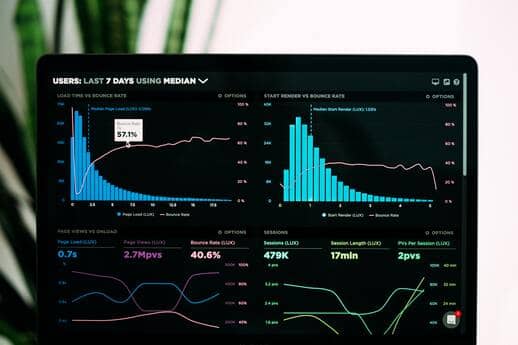
Top 10 Digital Marketing Metrics You Need to Track
Tracking the right digital marketing metrics is key to ensuring that you can properly evaluate and optimize your online marketing efforts. You must track, collate, and analyze marketing data to gather insights into your campaigns and SEO efforts. You must then identify the areas where you need to tweak or reallocate resources to boost results. But not all digital marketing metrics are created equal. So, what are the critical digital marketing metrics that you must track to get a comprehensive view of how well your campaigns are performing? Read on to find out.
1. Website Traffic
Knowing the number of visitors to your website helps you determine if there are seasonal fluctuations in traffic volume and identify the marketing channels or web pages that are driving the most traffic. Google Analytics is a free analytics tool that provides a wealth of data on website traffic.
Make note of metrics like the total number of visitors in a year and seasonal spikes or drops in traffic volume. This information helps you plan your marketing campaigns to improve results. For instance, you might want to post certain types of content at specific times of the year. Or you may want to scale up marketing efforts or focus on specific channels at other times.
You have to identify the platforms that are driving traffic to your website. You need this information to allocate your marketing resources more efficiently across channels. This data also helps you measure top-of-funnel performance. You must keep track of the number of visitors directed by the following marketing channels:
Direct
Direct visitors are those who had entered your company’s URL straight into the search bar or had bookmarked your site and returned. Data on direct visitors is a reflection of how well-known your brand is.
Referrals
These are visitors who were directed to your website when they clicked on a link on another site. This value can give you an idea of how well your link-building strategies are performing.
Organic Search
These visitors found your website on the search engine results pages after entering a keyword. This information helps you evaluate your SEO campaigns and keyword strategies.
Social
This is traffic that is directed from social media platforms like Facebook, Twitter, and LinkedIn and your blog posts.
Paid Search
This refers to traffic that is generated by your PPC (pay-per-click) campaigns.
This is traffic that is generated by your email marketing campaigns.

2. Pageviews
This is a broad-level metric, but it provides a comprehensive overview of page performance. This number indicates the number of times users load your page and identifies the pages that grab the most eyeballs.
Use this metric to create your content plan and SEO strategy. Identify the pages that get the most views. Place your links and CTAs (call-to-action) on these pages to maximize the chances of conversions and sales.
3. Average Session Duration
This is the amount of time visitors spend on your website or a particular page. Besides giving you an idea of how much your content resonates with your audience, this data is also an indication of how user-friendly your website is. Ambiguous navigation, prolonged page loading times, and internal links that don’t work are some issues that discourage visitors from exploring your site or returning to it.
Some advanced analytics tools can generate heatmaps to help you analyze how visitors interact with the various elements on a page. Use these insights and improve the pages to increase the time visitors spend on your site and boost conversions.
4. Bounce Rate
Bounce rate indicates the percentage of visitors who leave your site after viewing only one page and without taking any action. This is a powerful piece of data. It helps you evaluate your content strategy, marketing campaigns, and the quality of user experience that your website offers.

5. Exit Rate
The exit rate shows the percentage of visitors who leave a particular page on your site without taking any action. Identify the pages on your site with the highest exit rate, and work on them to improve their content and add interest and value.
6. Conversion Rate
This is the percentage of visitors to your website who take some form of positive action and fulfill one or more of your conversion goals. The positive action may be making a purchase that fulfills your business goal of increasing revenues. Another example of a positive action could be subscribing to your newsletter that fulfills your conversion goal of taking your top-of-funnel products to the greatest number of visitors.
Knowing the conversion rate of your website also helps you analyze the effectiveness of your marketing strategies and identify those that are leaking leads and failing to make sales.
7. Landing Page Performance
The landing page of a website is usually created to fulfill specific advertising or marketing goals, such as promoting a product, informing visitors of deals, or launching a service. The landing page is where visitors arrive after they have clicked on a hyperlink, which could be an ad or a link placed on your site or some other website.
Landing pages are designed to elicit some kind of positive action and generate specific marketing results. To maximize the efficacy of landing pages, you must keep track of the following metrics:
Total Landing Page Views
This number indicates the number of visitors to your landing page. Check for additional insights like the times when people have most visited the landing page or the specific events that have spiked views. For instance, if you are running PPC ads to your landing page, you can tweak the times you deliver the ads to increase landing page traffic. The data can also give you easy-to-miss insights, such as people visit your landing page more often when you run contests or quizzes on your Facebook page.
Total Conversions
This number gives you an idea of how efficiently your landing page is performing. This data helps you figure out if you need to write a catchier headline or a more compelling body copy than what you currently have on your landing page.
Conversion Rate
This value is the percentage of visitors who take some positive action, such as subscribing to your mailing list or purchasing a product. Compare the conversion rates of every landing page on your website to evaluate the efficacy of the pages and the campaigns.
Traffic Source
The number of visitors that come to your landing page through referring pages and ad campaigns indicates how each marketing channel is performing.

8. CTA (call-to-action) Performance
You need to measure the click-through rate (CTR) or how many visitors click on your CTAs. You must track two types of CTAs:
- Navigational CTAs: These CTAs direct visitors to the next stage of your sales funnel, such as clicking an ad or an embedded hyperlink that takes them to the landing page.
- Conversion CTAs: These CTAs are placed on landing pages.
CTRs help you determine whether or not you need to optimize your CTAs for performance. For instance, compare the values for CTAs on different pages of your site to figure out if a particular color or a specific choice of words affects CTRs. Implement small changes and carry out split (called A/B testing) testing to find out what works best.
9. Social Media Reach
Organic social media marketing means connecting with your audience through meaningful and relatable content. The goal is to build trust in the brand and encourage loyalty.
Track the number of shares your content generates across different social media platforms. For instance, you can see how many people liked and shared a post from your Facebook business page. Alternatively, you can use tools like Buzzsumo or Ahrefs to find out how many times your posts or pages have been shared across various channels. Detailed metrics like these help you evaluate how your marketing strategies are performing on different platforms.
10. Brand Mentions and Searches
Knowing how often you are mentioned and searched on the internet is an effective way to measure brand awareness. You can configure tools like Google Alerts to send you daily or weekly reports listing the websites that have mentioned your business. You can use Google Search Console to track how many people are searching for your brand.
Conclusion
No business wants to waste time nor the resources on ineffective marketing campaigns. That’s why it’s so important to identify the campaigns that are producing the desired business results as early as you can, so you can continue with them and replicate those models across other marketing channels. Tracking only these digital marketing metrics will help you stay on top of your marketing efforts without wasting time, money, and energy.
